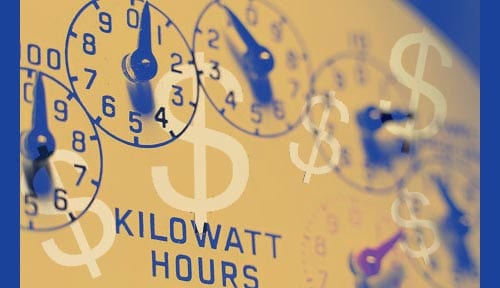Bill shock; we all dread the quarterly electricity bill and my first one under the July 2013 increase has just come in.
Being a hopeless geek, I quickly uploaded the data to my spreadsheet, called my utility to understand the incomprehensible gibberish cunningly described as “a bill” and managed to understand what they were talking about. This bill is particularly confusing because it’s crossed over the financial year rate rise; I pity the un-geeks in this world because “confusion is profit” never rang more true.
Duly following the links on the bill, I also located the comparative rates under different scenario’s – Flat rates and Time Of Use, which I volunteered for a year or two ago. I recall the reaction of many friends and colleagues when TOU was introduced which ranged from “what the ^&**(&*$#?” to “$0.45ckWh? Are they kidding? Who would agree to that?”, to even more colourful phrases. Undeterred, I have stuck with it as quasi academic exercise; and the results are now bearing fruit.
For comparison, in my area my TOU rates are now:
- Off Peak $0.119ckWh
- Shoulder $0.0199ckWh
- Peak $0.478ckWh
- Daily access charge is $0.79c day
If I elected to change to a flat rate:
- First 1000kWh $0.249ckWh
- Next 1000kWh $0.268ckWh
- Daily access charge is $0.71c day
So on face value, I wondered what the hell am I doing?
There are a few interesting things that I learned though.
Firstly, given that I had to pay for my meter to be installed and it’s fully digital (compared to my old rotary meter), I’m quite perplexed that I am charged almost 12% more per day for the “privilege” of being on TOU. In concert with the quite scary $0.478ckWh peak rate, I’m not surprised that most people take a quick look and decide not to sign up. For all the bluster about trying to incentivise demand savings clearly, my utility could give apparently two hoots. There is NO price signal in this equation that would attract anyone in their right mind after a cursory glance.
The other disincentive I hear from punters and electricity folks is that TOU price signals have limited traction; people do what they have to do when they have to do it. I can testify to that because with 3 kids and a busy life, my better half manages to work miracles and is aware, but barely focused on when electricity is used. On top of that, in our rental property we have little option but to use small electric heaters in strategic spots to warm our cockles in winter. We do our best and always see a surge in winter but still manage to keep our gross consumption down to under 12kWh/day, which is around half the comparable average.
I’m a bit more focused on it of course, and took another couple of steps this year by putting centralised, remote control standby switches in. We abandoned them after a month because they kept eating batteries, not working, or resetting the TV/Stereo system every time they were switched on and off – the cost of the irritating phone calls to make it work was far beyond the savings and marital greif. I remain optimistic that there is a better system out there, but haven’t found one yet. I also added a programmable timer to my electric bike so that I’m recharging in off-peak periods only, which saves money but doesn’t utilise my solar for recharging. Net CO2 compared to my combustion engined bike is still miles better and I do use solar for recharging on weekends, so i can live with that for now.
So TOU IS a signal, even to the non geeky types in our house and it IS having an impact. Our behaviour has changed.
What about the financials you ask?
We’ll even with our clumsy lifestyles and a higher daily access charge, we manage to save a little over 2% on our total costs on TOU rates. So it works financially too. I’ve graphed it so you can see the comparisons below.
 Now I can hear the skeptics out there saying “yeah sure, but you’re not normal Nige” (not for the first time I might add). So, to keep you happy, I doubled my consumption to the normal average consumption of 24kWh and remodeled the results below. The result? TOU still wins, but in this case the relative savings increase to almost 7.6% per quarter, assuming our time demand profile is the same.
Now I can hear the skeptics out there saying “yeah sure, but you’re not normal Nige” (not for the first time I might add). So, to keep you happy, I doubled my consumption to the normal average consumption of 24kWh and remodeled the results below. The result? TOU still wins, but in this case the relative savings increase to almost 7.6% per quarter, assuming our time demand profile is the same.
- Firstly, we can see that the signals are very different for our semi rural and regional cousins. If you were consuming energy like we do, TOU does NOT save you money; in Essential’s and in Endeavour’s area, you would be around 9% worse off
- Interestingly, if you are an average consumer (using 24kWh/day) in Essential’s area however, you WOULD save money on TOU, around 3%. If you are in Endeavour’s area however, you are still 4% worse off on TOU (which kind of explains why they only have a reported 5 TOU customers, doesn’t it)
- Yet again, I see evidence of dis-ingenuous pricing signals and a clear attempt to NOT get customers to take up TOU. Why? Because its works against the underlying premise of building more assets through increased demand or worse, if like me consumers do adjust behaviour, it makes less revenue for retailers.
- As a punter, with just a little bit of attention to detail, TOU can save you money; but not in every case.
My kingdom for a utility who can innovate!













